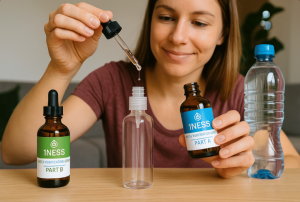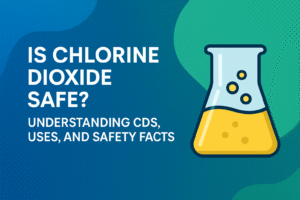Water is the essence of life, and its purity is crucial for our health and well-being. However, ensuring that the water we consume is free from harmful contaminants is a complex task. Understanding the safe levels of chlorine dioxide in drinking water is crucial for health and safety. One of the methods used to purify water is the addition of chlorine dioxide. But how much chlorine dioxide is safe in drinking water? This blog aims to answer this critical question, backed by scientific evidence and guidelines from reputable sources.
What is Chlorine Dioxide?
Chlorine dioxide is a chemical compound with the formula ClO2. It is a potent oxidizing agent used in various industrial applications, including water treatment. Unlike chlorine, chlorine dioxide is less corrosive and more effective at killing bacteria, viruses, and other microorganisms.
EPA Guidelines on Chlorine Dioxide Levels in Drinking Water
The United States Environmental Protection Agency (EPA) sets the standard for safe chlorine dioxide levels in drinking water at 0.8 milligrams per liter (mg/L). This concentration is both safe for human consumption and effective for water disinfection. Exceeding this limit can lead to health issues like eye, nose, and throat irritation, as well as respiratory problems. To achieve this safe chlorine dioxide concentration, you can use two drops of 28% sodium chlorite solution. When mixed with two drops of an acid like 4% hydrochloric acid or 50% citric acid, it produces approximately 10.5 mg of chlorine dioxide. Dilute this in 1 liter of water to meet the EPA’s recommended level.
Importance of Monitoring Chlorine Dioxide Levels in Drinking Water
Monitoring chlorine dioxide levels is crucial for public health and safety. Levels above the EPA guidelines can cause health problems, while insufficient levels may not effectively eliminate harmful microorganisms. Accurate measurement is key. For instance, combining two drops of 28% sodium chlorite with two drops of 4% hydrochloric acid or 50% citric acid yields around 10.5 mg of chlorine dioxide. This should be diluted in 1 liter of water to align with the EPA’s safe level of 0.8 mg/L.
Health Implications of Chlorine Dioxide in Drinking Water
Short-Term Exposure
Short-term exposure to chlorine dioxide at levels higher than the EPA’s recommended 0.8 mg/L can lead to immediate health concerns. These may include irritation of the eyes, nose, and throat. In more severe cases, high concentrations can cause respiratory issues, such as coughing and shortness of breath.
Long-Term Exposure
Long-term exposure to elevated levels of chlorine dioxide can have more serious health implications. These may include chronic respiratory problems and could potentially lead to conditions like asthma. Moreover, there is ongoing research to understand the long-term effects of chlorine dioxide on the human body, including its potential to cause cancer.
Also Consider reading our article on the longterm environmental impact of clean water.
Vulnerable Populations
Certain populations are more vulnerable to the effects of chlorine dioxide, such as infants, the elderly, and individuals with pre-existing health conditions. For these groups, even levels below the EPA’s maximum allowable limit could pose a risk.
Importance of Regular Monitoring
Regular monitoring of chlorine dioxide levels in drinking water is essential to ensure public safety. Water treatment facilities are required to adhere to strict guidelines and conduct frequent tests. However, it is also advisable for consumers to use water testing kits to check the chlorine dioxide levels in their home water supply.
Individual Responsibility
While regulatory bodies are in place to monitor and control chlorine dioxide levels, it is also the individual’s responsibility to be informed and take precautionary measures. This includes using certified water filters that can effectively remove excess chlorine dioxide and other contaminants.
Methods for Measuring and Reducing Chlorine Dioxide Levels
Measuring Chlorine Dioxide Levels
- Professional Testing: Water treatment facilities use advanced methods like spectrophotometry to accurately measure chlorine dioxide levels. These tests are highly reliable but are generally not feasible for individual use.
- Home Testing Kits: These are readily available and can be used by anyone to check the chlorine dioxide levels in their home water supply. While not as accurate as professional methods, they are sufficient for general monitoring.
- Digital Meters: These devices provide a quick and relatively accurate measurement of chlorine dioxide levels. They are more expensive than home testing kits but are reusable.

Reducing Chlorine Dioxide Levels
- Activated Carbon Filters: These filters are effective in removing chlorine dioxide and are commonly used in household water filtration systems.
- Reverse Osmosis: This method is highly effective but also more expensive. It is generally used in industrial settings.
- Boiling Water: Boiling can help in reducing chlorine dioxide levels but is not the most efficient method for complete removal.
- Distillation: This is another effective method but is generally not practical for large volumes of water.
Government Regulations and Guidelines
It’s crucial to be aware of the guidelines set by regulatory bodies like the EPA. These guidelines are in place to ensure that water treatment facilities are effectively reducing chlorine dioxide levels to the safe limit of 0.8 mg/L.
Consumer Awareness and Action
Being informed is the first step in ensuring your safety and that of your community. If you suspect that the chlorine dioxide levels in your water supply are higher than the recommended limits, report it to your local water authority immediately.
The Importance of Safe Chlorine Dioxide Levels and How Shop1ness.com Can Help
Understanding the safe levels of chlorine dioxide in drinking water is not just a matter of compliance with government regulations; it’s about safeguarding your health and that of your community. The United States Environmental Protection Agency (EPA) has set the safe limit at 0.8 milligrams per liter (mg/L). To put this into perspective, achieving this concentration would require adding approximately 2 drops of 28% sodium chlorite and 2 drops of 4% hydrochloric acid or 50% citric acid to one liter of water. It’s crucial for both water treatment facilities and individual consumers to take these precise steps to maintain safe levels of chlorine dioxide in drinking water.
By adhering to these guidelines, you not only protect yourself from potential health risks but also contribute to the overall well-being of your community. Shop1ness.com offers a range of water treatment solutions that can help you easily and accurately maintain these safe levels, ensuring that you and your loved ones can enjoy clean, safe water.
Why Choose 1ness Drops for Your Drinking Water Safety Needs?
When it comes to drinking water safety, don’t compromise. Choose Shop1ness.com, your one-stop solution for water quality and chlorine dioxide safety. Our water testing kits are designed for ease of use, complete with step-by-step instructions. Within minutes, you can determine if your water meets the EPA’s safety guidelines.
If your water needs treatment, our filtration systems are your go-to solution. These systems are engineered to help you achieve the optimal chlorine dioxide levels, ensuring that you and your family have access to clean, safe water every day.
But we’re more than just products. Our website is a treasure trove of educational resources. From how-to guides to expert articles, we empower you to take control of your water safety.
So why settle for less? Choose Shop1ness.com for all your water safety needs. Because when it comes to your health, every drop counts.




